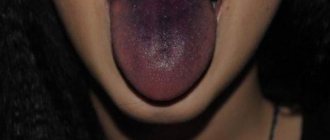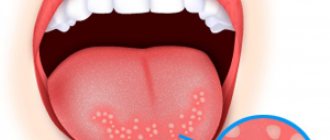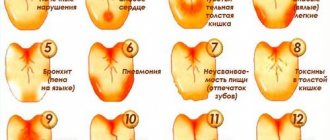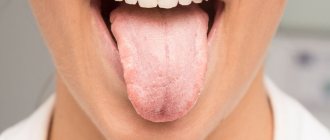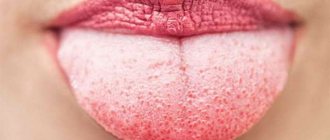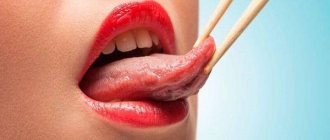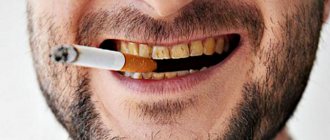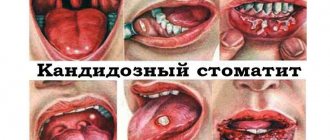4118
Even in ancient times, the tongue was considered the organ by which the health of the entire organism could be judged. Any changes that occur to it, be it thickening, change in color, the appearance of plaque, etc., suggest that there is some kind of internal problem or disease.
Brown plaque is also no exception. If this happened once and after normal cleansing did not happen again, then there is no need to worry . But the systematic formation of brown plaque on the surface of the tongue can already become a problem.
Causes of dark plaque on the tongue
Dark plaque of different shades in adults can occur for a number of reasons.
- Acute form of tonsillitis, tonsillitis, pharyngitis, tracheitis, bronchitis, pneumonia.
- A violation of the acid-base balance, in which the internal environment is acidified due to the accumulation of a large number of hydrogen ions and acidic products.
- Taking certain groups of antibiotics.
- Persistent thrush. At first, the coating on the tongue is white and has a cheesy consistency. But, as the disease progresses, it darkens and becomes thicker. This is especially noticeable in severe stages of the disease.
- Severe intoxication of the body (for example, lead). At the same time, a person feels a metallic taste in his mouth, his gums become grayish and very sensitive.
- Oncological processes in the gastrointestinal tract.
- The tongues of long-term smokers take on a dark brown tint.
- Abuse of products containing caffeine. Strong black tea, chocolate, and carbonated drinks cause brown plaque.
- Treatment with drugs containing iodine.
- If you are severely dehydrated or have a lack of oxygen in the blood.
- Diabetes, diabetic coma. In the latter case, the tongue becomes extremely dry, cracks and takes on a tea-colored color.
- In cases of gallbladder dysfunction and nephritis, the tongue turns brown-green.
- Cholecystitis. Inflammation in the gallbladder caused by the outflow of bile and infection of the intestinal microflora. Often affects women during pregnancy. In addition to nausea, frequent vomiting and severe pain, the patient has a fever, and the tongue is covered with a dry, yellowish-brown film.
- In case of ulcerative lesions of the stomach and intestines.
- Irregular oral hygiene, stomatitis and oral candidiasis.
- Crohn's disease (granulomatous enteritis). An autoimmune disease, accompanied by additional chronic bowel dysfunction (constipation) and inflammation of the digestive tract. Due to an increase in the volume of melanin in the body and dysfunction of the adrenal glands, the patient’s body becomes covered with large dark blue spots. They also appear on the tongue.
- If there are problems with the liver, a greenish film appears on the tongue.
- Alkaline balance disorder due to the fact that a person regularly eats a lot of flour, but avoids fresh fruits and vegetables.
- HIV.
- Cholera - the surface of the tongue becomes dark blue.
- Helminths and other parasites.
Why does brown plaque appear?
A brown coating on the tongue can be caused by an addiction to coffee and chocolate. Food products impart a light, translucent tint that disappears after brushing the tongue. If you limit the amount of cocoa and caffeine consumed, you may notice that the unusual plaque will disappear by itself. Brown plaque is a constant companion of smokers . The color saturation also depends on the frequency of smoking.
Depending on the shade of plaque and its location, one can judge the presence of serious diseases. A light brown color indicates impaired lymphatic drainage and inflammation in the joints. Also, such plaque occurs during exacerbation of chronic diseases of the upper respiratory tract .
The yellow-brown color indicates diseases of the gastrointestinal tract, bronchi or lungs. Chronic alcoholism also turns the tongue a “sick” color, and the problem is accompanied by an unpleasant odor. Some medications turn the tongue an unusual color.
The dark brown color of the tongue indicates severe complications. These include:
- liver and kidney diseases;
- viral respiratory diseases;
- chronic forms of gastrointestinal diseases;
- dysfunction of the gallbladder;
- dehydration.
Why does plaque remain on the tongue for a long time? If a pronounced brown tint persists for more than three days, then this situation may indicate dysbacteriosis and intoxication.
Causes of dark plaque in a child
When mentioning dark plaque in a child, it is necessary to especially note several more factors that adults often overlook:
- How often does your child eat foods containing dyes? These can be dark-colored drinks (lemonade, compotes, juices), chocolate bars, multi-colored caramel, berries (blackberries, blueberries, mulberries).
- Whether he sucks pencils and pen refills, or puts felt-tip pens or coloring toys into his mouth.
- Are they giving him iron supplements to raise the level of hemoglobin in the blood?
When not to worry
The use of certain medications causes the tongue to turn a particular color. Activated carbon turns black. Steroid drugs, Faringosept, Malavit - dark brown. Ulkavix, De-nol, Vikalin (drugs for the treatment of gastritis and heartburn) - in brown.
To identify false stains, conduct an experiment: within 3-4 days after brushing your teeth, brush your tongue. To do this, wrap a small piece of gauze around your finger, smear it with toothpaste and begin “sweeping” your tongue from root to tip.
Treat the right and left sides of the tongue in turn. Do not press or pull, but do everything carefully and smoothly so as not to damage the sensitive surface. After removing plaque, you should rinse your mouth with a healing herbal decoction or a special pharmaceutical product that protects against bacteria.
If the plaque is easily removed, the problem is due to foreign dyes and there is no reason to worry. Otherwise, observe for a few days. If there are no external factors that provoke staining, you need to consult a therapist or dentist. Moreover, a visit to the clinic should not be delayed if additional frightening symptoms appear.
How to get rid of plaque?
You can fight the coating on your tongue from smoking.
To do this, you need to monitor oral hygiene and brush your teeth, cheeks and tongue daily .
The following products can be used to clean the mouth :
- Toothbrush.
- Tea spoon.
- Gauze or bandage wrapped around a finger.
- A special scraper for removing plaque, which can be bought at a pharmacy.
- Special toothpaste for smokers.
Vegetable oil is also used to cleanse the tongue .
Preferably olive or flaxseed, since these types of oils not only help remove plaque, but also care for the oral mucosa.
They have antifungal and antibacterial properties, and also heal microtraumas.
Need to know! The procedure for cleansing the oral cavity with oil is carried out in the morning before breakfast.
To do this, you need to pour one tablespoon of oil into your mouth and dangle it there for at least ten minutes. After which the oil is spat out.
Classification
Plaque location:
- On the sides - indicates pathologies of the spleen and liver.
- In the center and further to the root - speaks of diseases of the gastrointestinal tract.
- At the tip - indicates diseases associated with the cardiovascular system.
The consistency of the plaque can be greasy, cheesy, wet or dry. By prevalence: cover the tongue completely, are located in the form of dots or spots of different sizes, have clear boundaries or vague shapes. Doctors experimentally determine how plaque is removed - easily; with effort, but without pain; hard and painful. The lighter the shade of the film and the more transparent the layer, the milder the disease.
How does smoking affect a person's language?
Smoking has a detrimental effect on the entire oral cavity, nasopharynx, bronchi and lungs.
Keep in mind! All mucous membranes are affected by toxic hot smoke. First of all, the tongue is negatively affected.
Nicotine affects the sensitivity of taste buds, which leads to a significant decrease in the sense of taste of food.
Medical studies have proven that smokers and non-smokers have significantly different taste sensitivity thresholds.
This indicates that nicotine contributes to the morphological and functional restructuring of taste buds.
Taste buds not only help you enjoy the taste of food, but also influence the process of salivation, digestion, and the secretion of gastric juice.
Symptoms
- Dry mouth;
- unpleasant odor;
- change in taste;
- periodic or constant strong thirst that cannot be drowned out by anything;
- lack of appetite;
- sudden weight loss;
- memory impairment;
- bowel dysfunction (diarrhea, constipation), flatulence;
- change in skin color (yellowness, cyanosis or conspicuous pallor);
- nausea and vomiting, frequent belching, heartburn;
- changes in blood pressure, increased heart rate, increased body temperature.
Symptoms in this case are an additional factor in the clinical picture.
Diagnostics
The therapist studies:
- Anamnesis and medical history of the patient;
- Urine and stool tests;
- A detailed and general blood test (to detect an increase in ESR, bilirubin, antibodies to Helicobacter, leukocyte levels);
- Tests aimed at detecting pathogenic bacteria and their types (bacteria culture from the oral cavity);
- Ultrasound results (abdominal cavity, thyroid gland, reproductive organs);
- X-rays, biopsies, fibrogastroduodenoscopy, duodenal intubation;
- If necessary, MRI and CT, endoscopic procedures.
If necessary, refers the patient to specialists:
- To the dentist – if oral diseases are suspected;
- Gastroenterologist - if there are suspicions of problems with the gastrointestinal tract;
- To a toxicologist – if Remarque’s disease (caused by lead poisoning of the body) is in question;
- Infectious disease specialist - for sore throat, cholera;
- Oncologist - if a tumor is suspected.
Treatment and prevention
Treatment of plaque on the tongue is aimed at eliminating the cause of its occurrence. Therefore, before starting it, you need to consult a therapist, and then undergo the prescribed examinations, based on which the doctor will be able to determine why a green coating has formed on the tongue. The main thing is not to delay your visit to the clinic, otherwise it will take a long time to treat the pathology.
To prevent pathology, dentists recommend rinsing your mouth with a decoction of calendula flowers. This is a powerful natural antiseptic that effectively fights pathogenic microbes. If you don’t have calendula, an analogue in tablets – Furacilin – is suitable.
There are many reasons why plaque appears on the tongue. Therefore, treatment without a medical diagnosis may turn out to be not so much useless as simply harmful.
Treatment methods
There is no such diagnosis - “dark coating on the tongue”, therefore treatment is carried out only after the specific cause of the disease has been established. As soon as you eliminate it, the unpleasant plaque will go away.
If the problem is inflammation of the tongue caused by improper oral care:
- Change your toothbrush;
- Wipe your tongue with diluted salicylic alcohol or 10% resorcinol solution. They have an antiseptic effect and successfully fight bacteria, heal ulcers and erosions. Antiseptics such as a solution of chlorhexidine, potassium manganese, and furatsilin are suitable for rinsing.
Traditional medicine recommends drinking a course of anti-inflammatory infusion of linden flowers, oregano, plantain and yarrow. Taking an equal handful of all the herbs, chop them, and pour one teaspoon of the mixture with a glass of boiling water.
Leave for at least three hours covered. Drink 100 ml of infusion twice a day for two weeks (before meals). Another option: 8 tsp. flax seeds are poured into a liter of water, brought to a boil, and cooled. You should drink it in the morning on an empty stomach for one and a half to two weeks. Rinsing with decoctions of oak bark, sage, and chamomile also helps.
If the cause is antibiotics, time will help. A week or two after the last dose, the plaque will disappear on its own. You can speed up the process by taking an anti-fungal drug and a remedy to improve the immune system.
If you have gray plaque, you should reduce the amount of salt you consume and take medications against bacteria and viruses.
Antibiotics and antifungal drugs, agents for increasing the flow of bile and restoring the structure of the kidneys, a complex of vitamins, and a solution for treating dehydration help remove yellow plaque.
Fungal diseases that cause the appearance of a repulsive brown plaque are treated with antifungal drugs (Flucostat, Fucis, Fluconazole) and probiotics (Bifidumbacterin, Linex, Bacteriobalance), injections of B vitamins. The throat is gargled with a soda solution, tablets are dissolved to maintain microflora (Lisobakt).
Blue Plaque
The tongue is a very sensitive organ and any malfunction in the body is immediately manifested by any changes on its surface, for example, it may turn blue. This shade has several particularly common reasons:
- Malfunctions of the heart. If the entire surface of the tongue is blue, then there are problems associated with blood circulation, and they are often accompanied by complications, for example, cardiovascular failure. There will be no other visible symptoms in the early stages of the disease, and this will make it possible to begin treatment of the pathology in its infancy;
- Lack of vitamin C. A blue surface on the tongue can be caused by an acute lack of ascorbic acid and this disease is called scurvy. In this case, the surface of the organ becomes loose, and the gums bleed heavily.
- Poor blood circulation. This problem manifests itself as a blue tint on the tongue and its causes can only be found out after an examination;
- Poisoning. It may occur due to ingestion of mercury or other heavy metals;
- Kidney problems. If the whole reason lies in them, then the blue coating is on the tongue near the pharynx;
- Malfunctions of the adrenal glands. In this case, the tongue becomes covered with blue-black spots, which will disappear when hormones begin to be produced normally.
Prevention
- Avoid products with dyes or reduce the amount of them.
- Rinse your mouth after eating or use a toothbrush.
- Maintain good oral hygiene.
- Lead a healthy lifestyle.
- Drink at least 1.5 liters of clean water per day.
- Give up alcohol and smoking, replace coffee and tea with herbal infusions.
- Follow safety rules when working in hazardous industries and with hazardous substances.
- Do not take medications without a doctor's prescription.
- Strengthen your body with hardening procedures, gymnastics and walks in the fresh air.
- Eat right: remove spicy, sugary and fatty foods, smoked foods, and fast food from your diet. Add foods with fiber (pumpkin, rye bread, bran, fresh vegetables). Drink kefir or natural yogurt every day.
- Choose a suitable vitamin complex for yourself. It must contain vitamins B2 (riboflavin), B6 (pyridoxine) and B3.
